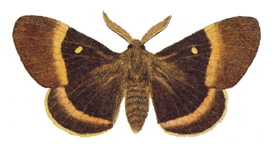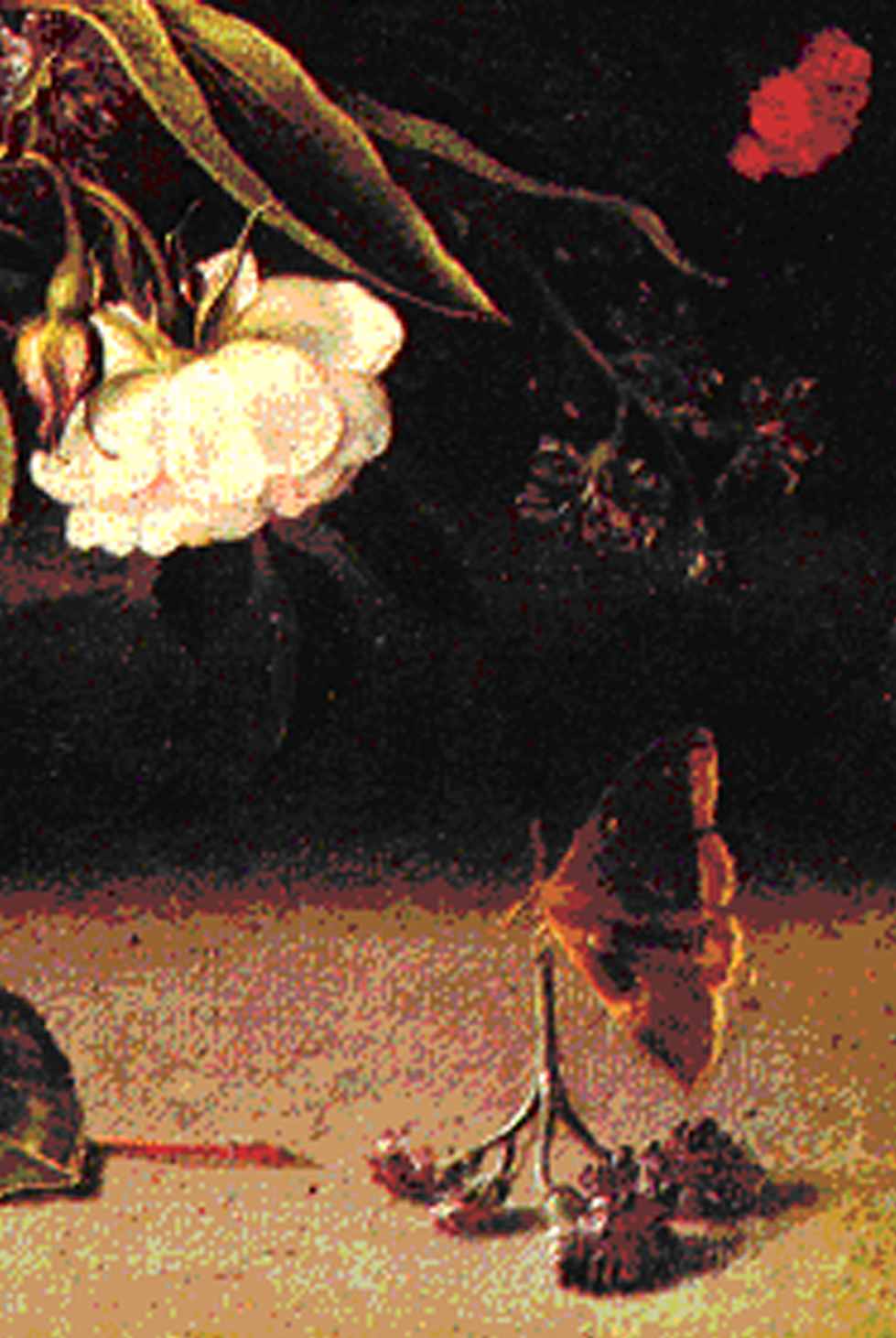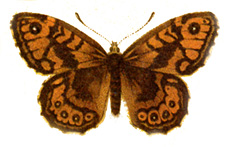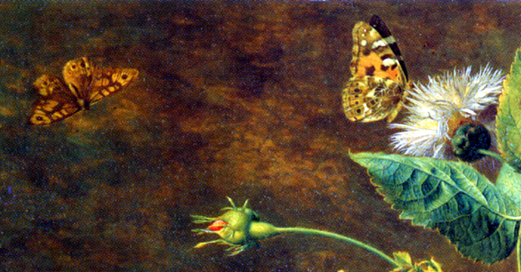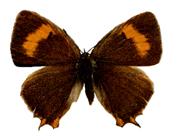Butterflies and Moths in Nabokov's Published Writings
Alphabetical Order ‒ Page 5
Lampides (ex Cosmolyce, Lycaena) boeticus Linnaeus, 1767 [Lycaenidae, Polyommatinae, Polyommatini, Lampides Section]: the Long-tailed Blue, a migrant blue in N Africa and the temperate zones worldwide.
*Lep2 270; Lep8 118
Laothoe amurensis (Yoshihiro Yanagita 2003)
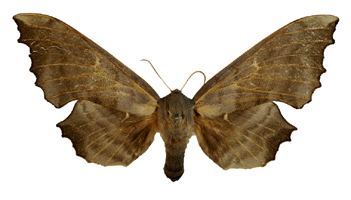
Laothoe (ex Smerinthus) amurensis Fischer von Waldheim, 1830, syn tremulae Staudinger 1892 [Sphingidae, Sphinginae]: a hawk moth of medium size (wingspan 57–86 mm) colored a marbled medium grayish brown. It lives in damp habitats near water and is known for its "semi-aquatic" lifestyle, whirring over lakes and rivers and dipping swallow-like to drink. The caterpillar lives mostly on aspens. The type locality was in the vicinity of Moscow, and the Aspen Hawk still is typical of Russia; it ranges from Finland, the Baltic states and Poland to Manchuria and N China.
*Stor:Xmas 134; SpeakM 156; NabBut 403
"… the dipping-the-abdomen habit noticed by me – and other Russian collectors – in the case of Smer. populi and S. amurensis ..."
*Lep12
"… that handsome grey-marbled moth… which, in happier days, I used to find at the foot of aspens in the neighbourhood of Petrograd".
*Lep1 33
"On a warm evening he would take me to a certain small pond to watch the aspen hawk moth swinging over the very water, dipping in it the tip of its body."
*Gift 109
For some reason Karges (1985) believes the Aspen Hawk to be Laothoe populi LINNAEUS, 1758; this, however, is the Poplar Hawk which, though similar, is a different species.
& Ac: Laóthoë/Smerínthus amurénsis/trémulae • En: Amur Hawk Moth, Aspen Hawk Moth • Fr: le smérinthe du tremble, (Don) le sphinx du tremble • Ge: Espenschwärmer • It: sfinge della tremula • Ru: бражник амурский • Sp: esfinge del álamo
Laothoe (ex Smerinthus) populi Linnaeus, 1758 [Sphingidae, Sphinginae]: a common hawk moth in the European lowlands, but found up to 1,500 m altitude. The range is from Europe across the Urals and the Caucasus to the Altai. The wingspan is 65–90 mm.
*NabBut 403; Lep12
& Ac: Laóthoë pópuli • Fr: le sphinx du peuplier • Ge: Pappelschwärmer • Ru: бражник тополевый, (Dar) осиновый бражник • Sp: cuerno verde
Larentia Treitschke, 1825: a genus of »Geometridae, subfamily Larentiinae. Many of its former members have been split off to other genera. The type-species is the European geometer moth Larentia clavaria Haworth, 1809, the Mallow.
Larentia turbata: »Colostygia turbata
Large Copper: »Thersamolycaena dispar
Large Emerald: »Geometra papilionaria
Large Tortoiseshell: »Nymphalis polychloros
Large White: »Pieris brassicae
|
Lasiocampa quercus (Sepp 1762) |
Linard: Corbeille de fleurs (detail, lower right-hand corner) |
|
|
|
Lasiocampa quercus Linnaeus, 1758 [Lasiocampidae, Lasiocampinae]: a lappet moth (»Lasiocampidae) in N Africa, Europe, Asia Minor, Caucasus, Russia, Altai. The wingspan in the males is 50–58 mm and in the females 60–68 mm. The color of the males is uniformly chestnut-brown, with wide wing margins of a lighter brown separated from the darker part by a pale yellow transverse band. There is a small white spot on the forewings halfway between tip and thorax. The females are patterned similarly, but the color is not brown but a light ochre-yellow.
In a painting (Corbeille de fleurs) in the Louvre by Jacques Linard (c. 1600–1645), Nabokov wanted to check for his »Butterflies in Art project if it was an Oak Eggar or a Peacock Moth ("quercus? pyri?"). The resting moth in the lower right hand corner of the painting is indeed hard to make out, especially in reproductions. An inspection of the original painting showed that it probably is a male Oak Eggar. The size, the brown color, the wide lighter margins and especially the two small spots instead of the four large eyes of pyri all point to it.
*SpeakM 132, 147; NabBut 640
& Ac: Lasiocámpa quércus • En: Oak Eggar • Fr: le minime à bandes jaunes, (Autres ravages) la Tordeuse du Chêne • Ge: (Großer) Eichenspinner, Quittenvogel • It: bòmbice della quercia • Ru: коконопряд/Эефир дубовый • Sp: lasiocampa del roble
Lasiocampidae Harris, 1841: a small family of medium to large moths, counting some 1,300 species, most of them in tropical India, Africa and S America. The name is derived from Greek lasios, shaggy, and kampi, caterpillar. Not only the caterpillars are shaggy, but also the adults.
& Ac: Lasiocampidae • En: lasiocampids, lappet moths • Fr: lasiocampidés, lasiocampes, livrées • Ge: Lasiocampiden, Glucken, Pelzspinner • It: lasiocampidi-bombici • Ru: коконопряды • Sp: lasiocámpidos
Lasiommata Westwood, 1841: a genus of »Nymphalidae, subfamily Satyrinae, tribe Parargini (GB browns). The type-species is »Lasiommata megera, the Wall Brown.
*NabBut 594 (BE)
Lasiommata (ex Pararge, Dira) maera Linnaeus, 1758 [Nymphalidae, Satyrinae, Parargini]: the Large Wall Brown, wingspan 37–50 mm, in N Africa, most of Europe and across Asia to W Siberia and Tianshan. "… very common in rocky places and in flowery fields. Fresh individuals are curiously gaudy on the wing, as they dance by with a flash of blue and a flash of red; one remember's Tutt's pleasing account of how completely baffled he was by the first maera he saw on a trip to the continent …"
*NabBut 594 (BE); Lep2 257, 269
& Ac: Lasiómmata máera • Large Wall Brown • Fr: l'arianne, le némusien • Ge: Braunauge • Ru: власоглазка Мера
|
The Wall Brown, Lasiommata megera (Berge 1899), and detail from a "Flower Piece" by Jan van Huysum (1682-1749), showing the Wall Brown (left) and a Painted Lady, Vanessa cardui. See also »Butterflies in Art. |
|
|
|
|
Lasiommata (ex Pararge) megera Linnaeus, 1758 [Nymphalidae, Satyrinae, Parargini]: the Wall Brown (wingspan c. 40 mm), in N Africa, Europe, Turkey, Levant, Iraq, Iran, Transcaucasia, Turkmenistan.
*Lep1 32; Lep2 256, 268
& Ac: Lasiómmata megéra • En: Wall Brown • Fr: la mégère • Ge: Mauerfuchs
Lasiommata (ex Dira) petropolitana Fabricius, 1787 [Nymphalidae, Satyrinae, Parargini]: a dark-brown satyrine with a wingspan of 34–40 mm flying on the higher mountain ranges of Europe, in Fennoscandia, in N Siberia, Mongolia, Amur region, NE China. Of the nominal subspecies Lasiommata petropilitana petropolitana, Nabokov noted: "One of the first Spring butterflies in Northern Russia, where it emerges as early as mid-May, and is completely replaced by D[ira] maera by the end of June." Between 1961 and 1975, Nabokov captured twelve specimens in the cantons Grisons, Ticino and Valais and in Piedmont.
*StrOps 334
& Ac: Lasiómmata petropolitána • En: Northern Wall Brown • Fr: la gorgone • Ge: Braunscheckauge • Ru: буроглазка малая
Lavatheria Verity, 1940: an abandoned genus of »Hesperiidae (skippers), Pyrginae (pyrgine skippers). The type-species was »Carcharodus lavathereae Esper, 1783, the Marbled Skipper, in N Africa. S Europe, Asia Minor, Iran.
*NabBut 577 (BE)
Lemonias zela: »Emesis zela
Leptidea Billberg, 1820: a genus of »Pieridae, subfamily Dismorphiinae. The type-species is »Leptidea sinapis, the Wood White. "As many fragile-looking butterflies the members of this genus are great wanderers."
*NabBut 587 (BE)
Leptidea sinapis (Lampert 1907)
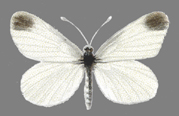
Leptidea (ex Leptosia) sinapis Linnaeus, 1758 [Pieridae]: one of the smallest and most delicate pierids, with a wingspan of 30–40 mm. Its range is Europe (except for the northernmost parts), Turkey, Near East, Caucasus to W Siberia and Tianshan. It is all white; the males have a black blot in the apex of their forewings.
*NabBut 587 (BE); Lep1 31; Lep2 257, 268
& Ac: Leptídea/Leptósia sinápis • En: Wood White • Fr: la piéride de la moutarde • Ge: Senfweißling, Tintenfleck • It: pieride della senape • Sp: blanca esbelta • Ru: белянка горошковая
Leptidea sinapis corsica Verity, 1911 [Pieridae]: a valid subspecies of the Wood White, found only in Corsica.
*NabBut 587 (BE)
Leptotes Scudder, 1876: a genus of »Lycaenidae, subfamily Polyommatinae (blues), tribe Polyommatini, Leptotes Section. The type-species is »Leptotes cassius.
Leptotes callanga Dyar, 1913 [Lycaenidae]: the Callanga Blue, in S Ecuador, Peru, NW Bolivia. The color is "a gleaming aster blue, margin with very narrow black border".
*NabBut 383 (L)
Leptotes cassius Cramer, 1775 [Lycaenidae]: the Cassius Blue, in Florida, S Texas, Mexico and S America.
*NabBut 383 (L); Lep9 2
Leptotes marina Reakirt, 1868 [Lycaenidae]: the Marine Blue, from the N American Midwest to C California and through Texas to C America.
*StrOps 327; NabBut 383 (L)
lesser fritillary, Krolik's: »Krolik's Lesser Fritillary
Lethinae: an abandoned subfamily of the family Satyridae (now Nymphalidae, Satyrinae), constructed around the genus Lethe Hübner, 1819, with Lethe europa Fabricius, 1775 as the type-species, the Bamboo Treebrown in SE Asia and Japan. In more recent classifications, the subfamily is submerged in the tribe Parargini (GB browns).
*NabBut 593 (BE)
Leucanitis caylino: »Drasteria cailino
Libythea Fabricius, 1807: a genus of »Nymphalidae, subfamily Libytheinae, snout butterflies. The type-species is »Libythea celtis. "A remarkable genus, containing the remnants, perhaps, of a much greater group, with species scattered over different parts of the world with only one or two species in each, sometimes insular."
*NabBut 230 (FB), 603 (BE)
Libythea celtis (Hofmann 1894)
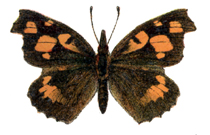
Libythea celtis Laicharting & Fuessly, 1782 [Nymphalidae, Libytheinae]: the only European representative of the »Libytheinae, or Snout Butterflies, which have their name from their long, snoutlike palpae. The wingspan is 55–70 mm, the color gray brown with orange marks, the wings are strongly notched or "toothed". It flies from N Africa across S Europe and Asia to Japan and Taiwan.
"The butterfly is a migrant and is only sporadically common in the more northern parts of S. Europe, wherever Celtis australis grows ... I have seen it appear regularly [in] spring on the south coast of Crimea, and it is widely distributed throughout N. Africa and Asia. It has been observed congregating in enormous numbers on celtis shrubs in Greece, somewhat like D[anaus] plexippus on pines. Its northernmost capture is Czechoslovakia … The mechanism of its movements is obscure".
*NabBut 603 (BE); Lep1 31–31; Lep2 256; LtVé 177
& Ac: Libythéa céltis • En: Nettle-tree Butterfly, European Snout • Fr: l'échancré • Ge: Zürgelbaumfalter • Ru: (бабочка-)носатка • Sp: mariposa del almez
Libytheana bachmanii Kirtland, 1852 [Nymphalidae, Libytheinae]: the Snout Butterfly or Eastern Snout, a migrant butterfly of a very small family, ranging from the Great Lakes to Mexico. "I saw, but could not catch, a very rare migrant butterfly (L. bachmanni)" (Nabokov in a letter to Edmund Wilson, Sep 3, 1948).
*N/WLet #182=147old; NabBut 604 (BE)
Libytheinae Boisduval, 1833 [Nymphalidae]: a small cosmopolitan subfamily of butterflies consisting of only a dozen species, most of them in S America. There are but two genera: »Libythea in the Old World, Libytheana in the New World. Their main characteristic are their very long two labial palpae looking like a beak or a snout, earning them the common name 'snout'. Libythea is 'the Libyan Goddess'. Earlier authors considered the snouts a family of their own (Libytheidae).
*NabBut 603 (BE)
& Ac: Libytheínae • En: snout butterflies • Fr: libythées • Ge: Schnauzenfalter, Palpenfalter • It: libitidi • Ru: носатки • Sp: libiteidos
Lime Hawk: »Mimas tiliae
Limenitis Fabricius, 1807: a genus of »Nymphalidae, subfamily Limenitidinae (admirals). The type-species is »Limenitis populi Linnaeus, 1758, the Poplar Admiral. *NabBut 207 (FB), 602 (BE)
Limenitis populi, female (Procházka 1963)
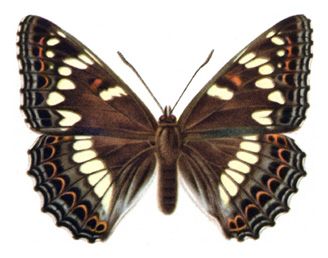
Limenitis populi Linnaeus, 1758 [Nymphalidae]: This is a stately Palearctic butterfly with a wingspan of 65–80 mm, dark brown with white marks and red crescents along the borders, flying in the humid deciduous woodlands and in mountain valleys of the temperate zone of Eurasia from France to Japan, in June and July. The common English name is Poplar Admiral. Nabokov preferred to use the old form, Admirable.
In The Gift, there is "a huge butterfly, flat in flight, bluish-black with a white band". It "described a supernaturally smooth arc, settled on the damp earth, closed its wings and with that disappeared … On occasion you find four black-and-white wings with brick-colored undersides scattered like playing cards over a forest path: the rest, eaten by an unknown bird." What is it? The two butterflies the description fits best are Azuritis reducta Staudinger, 1901, the Southern White Admiral, and Ladoga camilla Linnaeus, 1767, the White Admiral. Their wings which have white bands are actually bluish-black; as a matter of fact, the German common names of both have been 'Blauschwarzer Eisvogel'. However, they are not huge (the wingspan of reducta is only 45 mm and that of camilla only 52), and both fly too far south of St. Petersburg. That leaves two closely related candidates. Both are about the same size ("huge" for European standards), both are a blackish brown with white bands above, and both fly in the region of St. Petersburg. They are the Purple Emperor (»Apatura iris) and the Poplar Admiral. In the Purple Emperor, males and females have white bands across the hindwings that are broken into white marks on the forewings; in the Poplar Admiral only the females have similar white bands while the males have a mere hint of them. On the basis of Nabokov's description it is hard to decide which of them Nabokov had in mind. Were it not for that "bluish-black" sheen on the wings, the Poplar Admiral would in every respect be more likely. It is larger, and it has more brick-color on the underside. But all manuals agree that it is dark brown and not bluish-black. However, in Speak, Memory Nabokov calls the Poplar Admirals "great blue-black nymphalids striped with pure white," so he obviously did perceive a bluish sheen. There he also refers to their vanishing trick which will have worked especially well on the red clay of the banks of the Oredezh: "… gliding and wheeling above the rich clay which matched the tint of their undersides when they settled and closed their wings." So the bluish-black butterflies with the white bands and the brick-colored undersides of The Gift probably are females of the Poplar Admiral. There is a particularly dark form reported also from the region of St. Petersburg, lacking the white: the 'aberration' tremulae Esper.
In "Father's Butterflies", there is "Orlov's strain of Limenitis" (орловская раса тополевой «лименитии», 'тополевой' – poplar – missing in Nabokov's Butterflies). Professor K.A. Efetov believes 'Orlovskaya' in this case does not refer to a person by the name of Orlov (unknown in lepidoptery) but to the town of Orel, 300 km S of Moscow. Thus "Orlov's strain of Limenitis" should be "the Orel race of the Poplar Admiral".
The alleged subspecies semiramis Schrank, 1801 is no more, having been synonymized under populi. It had been described from Upper Franconia, and in his notes for The Butterflies of Europe Nabokov says: "I saw it in a wood near Marienbad, settling on the flowers of a bush, quite unlike the northern bucovinensis".
*Gift 78; SpeakM 129, 133; StrOps 334; NabBut 207 (FB), 602 (BE)
& Ac: Limenítis pópuli • En: Poplar Admiral, (Nabokov) Poplar Nymph • Fr: le grand sylvain • Ge: Großer Eisvogel • It: grande silvano • Ru: лентокрыльница тополевая, (DarII) тополевая лименития
Limenitis populi bucovinensis Hormuzaki, 1897 [Nymphalidae]: the Bucovinian subspecies of the Poplar Admiral, flying in Romania, Bucovina, Altai, Kentai, Mongolia, Amur and Ussuri regions. Nabokov captured it at the age of nine. He mistook it for a subspecies hitherto undescribed and sent it to the Russian lepidopterist »Kuznetsov, hoping he would recognize it as "new" and name it "Limenitis populi rossica" but earning the curt and disappointing reply that it had recently been described by »Hormuzaki.
*SpeakM 133; NabBut 602 (BE)
Limenitis reducta: »Azuritis reducta
Limenitis rivularis: »Neptis rivularis
Lobster Moth: »Stauropus fagi
looper (or inchworm): any geometer moth (»Geometridae), named for the looping, measuring locomotion of the caterpillars.
*LaughD 160; SpeakM 44
Lopinga achine Scopoli, 1763 [Nymphalidae, Satyrinae, Parargini]: the Woodland Brown, "one of the very few exclusively woodland butterflies of Europe," from the NW of the Iberian Peninsula and France through C Europe (on the decline) and S Fennoscandia across temperate Asia to Japan.
*NabBut 593 (BE)
& Ac: Lopínga achíne • En: Woodland Brown • Fr: la bacchante • Ge: Gelbringfalter
Lorelei Underwing: one of the invented insects of Ada. In his copy, Nabokov glossed 'Lorelei Underwing' as Catocala lorelei (Boyd, personal communication); hence this is the Latin name he intended. Many underwings have names suggestive of the marital status of women (electa, nupta, sponsa, adultera). Lorelei is the Sirene in German folklore who sitting on a rock above the river Rhine lures fishermen to their doom, the German conspecific of la belle dame sans merci made famous by Heine's well known ballad, beginning "Ich weiß nicht, was soll es bedeuten" (I don't know the meaning).
*Ada 56
& Fr: (Ada) Catocala lorelei • Ge: *Lorelei-Ordensband
Luna: »Actias luna
Luperina berylae Vand.: a moth invented by Nabokov for the villain of Conan Doyle's Sherlock Holmes story The Hound of the Baskervilles (1902), a man by the name of Stapleton. Stapleton is a descendant of the black sheep of the Baskerville family scheming to come into possession of their estate and fortune by killing the two intervening heirs. Unrecognized, he is living as a neighbor to Baskerville Hall in Devonshire. He is also a naturalist, hiking upon the gloomy Dartmoor with a green butterfly net. In his house he has what he considers the "most complete [collection of Lepidoptera] in the southwest of England". Before he came to Devonshire, Stapleton had a criminal career of sorts in South America and in Yorkshire where he was an infamous schoolmaster. The name he used there was Vandeleur. Sherlock Holmes finds out from the British Museum "that he was a recognized authority upon the subject [of entomology], and that the name of Vandeleur has been permanently attached to a certain moth which he had, in his Yorkshire days, been the first to describe". Luperina berylae is the name Nabokov suggests for Stapleton's moth. Why a Luperina? Luperina Boisduval, 1829 is an actually existing genus of noctuids, subfamily Noctuinae; the type-species is Luperina testacea Denis & Schiffermüller, 1775, the Flounced Rustic, a European owlet moth. Literally, the name means 'the gloomy one' – Luperina berylae is 'Beryl's gloomy Owlet Moth,' in keeping with the tone of the story. Beryl née Garçia is Stapleton's abused wife and accomplice, formerly "one of the beauties of Costa Rica". In dog-Latin the name may be understood to mean 'the cute little she-wolf and prostitute (lupa),' a still more telling characterization.
The moth Luperina berylae has nothing at all to do with the "small fly or moth" Stapleton runs after during his first encounter with Dr. Watson. This, he says, is "a Cyclopides". Cyclopides Hübner, 1819 is an abandoned genus of Hesperidae (skippers), subfamily Hesperiinae; the type-species was Cyclopides steropes Denis & Schiffermüller, 1775. The name has been synonymized under Heteropterus Duméril, 1806. 'Cyclopides' may have been a pre-Nabokovian joke on Conan Doyle's part that Nabokov certainly appreciated. There was a British entomologist by the name of E.Y. Watson who in 1893 had proposed a new classification of the skippers, placing many members of Cyclopides in his own new genus Kedestes. So Stapleton tells unsuspecting Dr. Watson that he is skipping after one of the other Dr. Watson's skippers. See also under »vandeleuri.
*N/WLet #138=110old
Lycaeides Hübner, 1819: an abandoned genus of »Lycaenidae. The type-species was Lycaeides argyrognomon Bergsträsser, 1779. The name has been superseded by »Plebejus.
This is the genus Nabokov did most morphological and taxonomic research on. He wrote three technical papers on its N American members. The first one (Lep7, 1943) dealt with their classification and introduced a new subspecies, »Lycaeides melissa samuelis, that became known as the Karner Blue. (In 2011 it has been promoted to species rank, Plebejus samuelis.) The second (Lep8, 1944) commented extensively on the morphology of the genus. The third and longest one (Lep14, 1949) was a thorough revision of the N American Lycaeides forms. In the course of his work, Nabokov reduced the number of Lycaeides species.
According to Nabokov, what distinguishes the genus from other genera in the subfamily »Plebejinae (which in »Eliot's classification of 1973 was to become the »Polyommatus Section within the tribe Polyommatini) is a certain structural characteristic of the male sexual organ, namely "an uncus (including the falces) exceedingly different from the corresponding structure found in other subdivisions" (Lep8, p. 107). What is an uncus? "The strongly hooked, mid-dorsal process that may frequently be highly diversified in shape, may be hairy or spinose, arising on the hind margin of the tegumen in male Lepidoptera", according to the Dictionary of Insect Morphology by Zombori & Steinmann (Berlin 1999). Incidentally, the tegumen is "the arcuate or roof-like structure of the genital armature of male Lepidoptera," and the falces are "the heavily chitinized, sickle-like paired processes below the uncus … in various groups of Lepidoptera".
Nabokov came to the conclusion that in Europe and N America the genus Lycaeides has just three species: Holarctic »idas (until 1954: argyrognomon), Nearctic »melissa and Palearctic argyrognomon (until 1954: ismenias) (Lep14 479). The "cradle" of the genus, according to Nabokov (Lep8 111), "is a lost country of plenty beyond the Arctic circle of today; its nurseries are the mountains of central Asia, the Alps, and the Rockies". The range is "from the polar regions to just below latitude 40° in Europe and Eastern North America, and to at least 30° in western North America and Asia".
Lep7 still recognized "at least half-a-dozen structural (genitalic) unities which may be termed species" in N America, clustering around three categories: argyrognomon (today idas), scudderi and melissa. In Lep14 (p. 480–482), Nabokov included the American scudderi (as well as the C Asiatic agnata and the E Asiatic subsolanus) in argyrognomon. In consequence, there were only two species left in America, argyrognomon (= idas) with ten subspecies and melissa with four.
Before the genus was abolished, Nabokov's reduction of the American members to only two species (idas and melissa) had withstood the test of time. The number of recognized Eurasian species, however, had increased. These were,
◦ agnata Staudinger, 1889 (mountains of Asia)
◦ argyrognomon Bergsträsser, 1779, syn ismenias Meigen, 1829
◦ egus Chapman, 1917 (Europe, Caucasus, Siberia, Mongolia, Amur region)
◦ idas Linnaeus, 1758 (Europe, Siberia, Yakutia, Alaska)
◦ subsolanus Eversmann, 1851 (mountains of S Siberia, N Mongolia, Amur region)
◦ christophi Staudinger, 1874 (Caucasus, Kurdistan, deserts in C Asia)
◦ ida Grum-Grzhimaylo, 1891 (mountains of S Mongolia, E Himalayas)
◦ samudra Moore, 1875 (W Himalayas)
When Bálint & Johnson in 1997 rearranged the whole Polyommatus Section, the genus was submerged in the much larger genus Plebejus Kluk, 1802 where, along with a number of other species, it forms the idas-group. The name Lycaeides disappeared. For details on this change, see under »Lycaenidae. Accordingly, all Lycaeides species and subspecies will be found under »Plebejus.
In his commentary to Lolita, Alfred Appel, Jr. writes: "While I was visiting [Nabokov] in 1966, he took from his shelf his copy of Alexander B. Klots's standard work, A Field Guide to the Butterflies (1951), and, opening it, pointed to the first sentence of the section on 'Genus Lycæides Scudder: The Orange Margined Blues,' which reads: 'The recent work of Nabokov has entirely rearranged the classification of this genus' (p. 164). 'That's real fame,' said the author of Lolita. 'That means more than anything a literary critic could say'" (p.326). Klots erred only when he credited Samuel »Scudder with the name 'Lycaeides'. It was introduced half a century earlier by Jacob »Hübner.
*Lol 326; StrOps 187, 319–320; N/WLet #78=66old, #95=82old, #102= 87old, 185= 150old; SelLet 102, 414, 500; NabBut 297, 302, 303, 342, 347 (L), 450 (L), 622 (L); Int1 E8; Lep7 passim; Lep8 passim; Lep9 44, 47; Lep14; Lep15
Lycaeides species: see under »Plebejus
Lycaeides cleobis (kenteana): »Plebejus subsolanus
Lycaeides ismenias Meigen, 1829 [Lycaenidae]: an obsolete name of what since 1954 is »Plebejus (ex Lycaeides) argyrognomon Bergsträsser, 1779. A synonym of ismenias was aegus Chapman, 1917. Meigen's old name was revived by Heydemann in 1931.
*NabBut 469 (L); Lep7 88, 89; Lep8 105–106; Lep14, passim
Lycaena Fabricius, 1807: a genus of »Lycaenidae, subfamily Lycaeninae (coppers). Lycaena is the type-genus of the family. The type-species is »Lycaena phlaeas, the Small Copper. The name means 'she-wolf'.
*StrOps 320; NabBut 210 (FB), 230 (FB); Lep8 125; Lep9 2
& En: coppers • Fr: cuivrés • Ge: Feuerfalter • Ru: настоящие голубянки, червонцы
Lycaena alciphron: »Thersamolycaena alciphron
Lycaena alciphron gordius: »Thersamolycaena alciphron gordius
Lycaena amandus: »Polyommatus icarius
Lycaena arion: »Maculinea arion
Lycaena baton: »Pseudophilotes baton
Lycaena baton albonotata: »Pseudophilotes baton var. albonotata
Lycaena babhru: »Madeleinea moza
Lycaena bellargus: »Polyommatus bellargus
Lycaena cupreus snowi (not snowii) W.H. Edwards, 1881 [Lycaenidae]: Snow's Lustrous Copper, on flowery meadows and near brooks at high altitudes in the Rocky Mountains.
*StrOps 316; NabBut 478 (L); Lep16
Lycaena cyllarus: »Glaucopsyche alexis
Lycaena dispar: »Thersamolycaena dispar
Lycaena endymion: about this alleged species of S American blues, Zsolt Bálint explains, "Nabokov listed (with question mark) Lycaena endymion BLANCHARD, 1852 (TypeL Coquimbo, Chile) as synonym of [Pseudolucia] collina criticizing the act of Kirby (1871: 377), who gave the sibylla replacement name for endymion. The action of Kirby is valid in spite of the correct note of Nabokov (Bridges 1988: I. 320). Nabokov listed sibylla as junior objective synonym of chilensis by mistake" ("A Catalogue of polyommatine Lycaenidae [Lepidoptera] of the Xeromontane Oreal Biome in the Neotropics As Represented in European Collections", Reports of the Museum of Natural History University of Wisconsin [Stevens Point], 29, no year, p. 18).
Hence 'endymion' is Pseudolucia sibylla Kirby, 1871, in the High Andes of N Chile.
*SelLet 55
Lycaena escheri: »Polyommatus escheri
Lycaena ganssuensis: »Plebejus idas ganssuensis
Lycaena helle: »Helleia helle
Lycaena heteronea: »Chalceria heteronea
Lycaena hippothoe: »Palaeochrysophanus hippothoe
Lycaena hylas: »Polyommatus dorylas
Lycaena icarus: »Polyommatus icarus
Lycaena mariposa: »Epidemia mariposa
Lycaena martha: »Echinargus martha
Lycaena medon: »Aricia agestis
Lycaena melanops: »Glaucopsyche melanops
Lycaena phlaeas (Lampert 1907)

Lycaena (ex Chrysophanus, Heodes) phlaeas Linnaeus, 1761 [Lycaenidae]: a small butterfly with a wingspan of 22–27 mm, the forewings colored a bright copper with dark spots and narrow black margins, flying in all of the Palearctic as well as in the eastern lowlands and the Rocky Mountains of N America. It is still abundant from the Canary Islands, Madeira and N Africa through nearly all of Europe E across temperate Asia to Japan.
Lycaena phlaeas is the type-species of the genus Lycaena Fabricius, 1807 and as such something like the prototype of all the lycaenines (coppers), of course not because it is more Lycaena-like than all the others but for purely entomohistorical reasons.
*SpeakM 132; NabBut 398 (L), 448 (L), 478 (L); Lep2 256, 268; Lep16
& Ac: Lycáena/Heódes/Chrysóphanus phláeas • Am: American Copper • En: Small Copper • Fr: le cuivré commun • Ge: Kleiner Feuerfalter, Feuervögelchen • It: argo bronzeo • Ru: червонец пламенный, червонец пятнистый • Sp: manto bicolor
Lycaena (ex Chrysophanus) phlaeas feildeni M'Lachlan, 1878 [Lycaenidae]: Feilden's Copper, an artic subspecies of the American (or Small) Copper, in NW Greenland, Ellesmere Island, Baffin Island and Southampton Island. Nabokov says he took it in the Tetons. ("L. fieldeni" is a misspelling.)
*NabBut 478 (L); Lep16
Lycaena sebrus: »Everes decoloratus
Lycaena semiargus: »Polyommatus semiargus
Lycaena thersamon: »Thersamonia thersamon
Lycaena thersites: »Polyommatus thersites
Lycaena thoe: »Hyllolycaena hyllus
Lycaena tityrus: »Heodes tityrus
Lycaena virgaureae: »Heodes virgaureae
lycaenid: any butterfly of the large family of »Lycaenidae
*Ada 420; SelLet 102–103
|
Lycaena phlaes, the type-species of the subfamilie of Lycaeninae (Lampert 1907) |
Polyommatus icarus, male and female, the type-species of the subfamily of Polyommatinae (Hübner 1793-1827) |
Thecla betulae, the type species of the subfamily of Theclinae (Verity 1943) |
|
|
|
|
Lycaenidae Leach, 1815: the largest and most diverse family of butterflies, comprising some 6,000 species world-wide, most of them in the tropics, especially in SE Asia. There are about species 1,000 in Eurasia and 100 in N America.
These are their distinctive characters : the base of the antennae is adjacent to the eye; the forelegs in the males are incompletely developed and not used for walking; and the radial vein in the forewings lacks one or two forks. Lycaenids generally are of small to medium size, with wingspans between 30 and 40 mm (minimum 12, maximum 85). A few of the smallest butterflies are lycaenids.
Sometimes all of them are equated with 'blues,' a misleading way of speaking as by no means all of them are blue. (Of the blues in a narrower sense, that is, of the members of the subfamily Polyommatinae, not all but most of the males are blue.) Whenever they actually are blue or copper, these are "structural" colors, produced without pigments by the refraction of the scales. Hence they have a metallic luster and are permanent. The American common name 'Gossamer Wings' emphasizes the silky and delicate nature of their wings. As they are fragile, they must be handled very carefully.
The scientific name is derived from Greek lykaina, she-wolf, one of Aphrodite's surnames. The type-genus is »Lycaena Fabricius, 1807.
As this is the family Nabokov did most of his entomological research on, a few remarks on its further subdivisions are required.
As was bound to happen with such a large and heterogenous taxon, a bewildering multitude of intermediate taxa have been proposed. Nabokov was working at a time when no consensus was in sight. The first modern systematic reviews of the whole of this cosmopolitan family were published only years after he left the workbench. They were "A revised classification of the butterfly family Lycaenidae and its allies" by Harry K. »Clench (Annals of the Carnegie Museum, 33, 1955, p. 261–275) and "The higher classification of the Lycaenidae (Lepidoptera): A tentative arrangement", by the British researcher John Nevill »Eliot (Bulletin of the British Museum [Natural History] Entomology [London], 28 (6) 1973, p. 371–505).
Eliot's work profited from previous research by Henri »Stempffer and even more so by Clench and attempted to apply uniform criteria to the whole of the family. He took into account the structure of male genitalia, the characters of the head (especially the antennae), legs and wings and various additional features.
In his 1973 paper, Eliot divided the Lycaenidae into eight subfamilies and these into twenty-nine tribes; the tribes in turn are divided into more than seventy sections. The great increase on three levels is due to the fact that earlier classifiers had limited themselves to a few fauna zones while Eliot was the first to arrange the whole of the worldwide family. His original intention had only been to prepare a key (that is a checklist of features which would allow to distinguish the different taxa) for the Oriental lycaenids, a group particularly rich in number and variety. As his work progressed, he saw that he could not do so without the framework of the whole family.
Of Eliot's eight subfamilies, only three occur in N Eurasia and the Americas. They correspond to "the traditional popular trinity of »'Blues,' »'Coppers' and »'Hairstreaks'": Polyommatinae Swainson, 1827, Lycaeninae Leach, 1815 and Theclinae Swainson, 1831.
In his subsequent taxonomic work on Oriental lycaenids Eliot arrived at the conclusion that the number of subfamilies should be reduced to five: Riodininae, Curetinae, Poritiini, Miletinae and Lycaeninae. In this scheme the traditional subfamilies of Lycaeninae, Theclinae and Polyommatinae become tribes of Lycaeninae (Lycaenini, Theclini and Polyommatini). Ackery, de Jong & Vane-Wright (1999) have adopted this classification (J.N. Eliot, "Notes on the genus Curetis Hübner (Lepidoptera, Lycaenidae)", Transactions of the Lepidopterological Society of Japan, 41, 1990, p. 201–225).
The type-genus of the Lycaeninae or Lycaenini (coppers) is »Lycaena Fabricius, 1807 whose type-species is the Small Copper, »Lycaena phlaeas. There are only about 50 species, mostly in Eurasia and N America. Not all of them are of a copper color; there are some that are blue, purple, brown, gray or even yellow. Their flight is strong and fluttery.
The type-genus of the Theclinae or Theclini (hairstreaks) is »Thecla Fabricius, 1807. There are around 2,000 species worldwide, most of them in the S and C American tropics. Their most distinctive mark is that they have only ten, eleven or twelve forewing veins. Quite often they are blue or golden green on the dorsal side; the ventral side has a complicated pattern of delicate white and brown streaks. The males generally have a tiny filamentous tail on their hindwings. Either the streaks or the tails or both earned them the common name hairstreaks (in German it is 'Zipfelfalter'). They are swift, erratic flyers. The type-species of Thecla is the Brown Hairstreak, »Thecla betulae. Thecla is a Greek women's name.
The type-genus of the numerous Polyommatinae or Polyommatini (blues) is Polyommatus Latreille, 1804; the type-species of the genus is the Common Blue, »Polyommatus icarus. 'Polyommatus' means 'the many-eyed one'. The name refers to the many small ringed spots on the undersides of the wings. As with the coppers, the range of the blues generally is more to the north than that of the hairstreaks. Their forewings usually have eleven veins. The males frequently are blue, the females brown. But as not all of them are blue, and as blue lycaenids may also be found outside the Polyommatinae, the word 'blues' should not be taken too literally even for this subfamily. The sexual dimorphism in color serves a purpose: it is a conspicuous signal that alerts females to the males and prevents males from chasing after other males of their species, instead of the females they want. Their flight is weak and fluttery. While most of them stay close to the tops of their hostplants, some of them migrate. They rest with their wings closed and sip flower nectar. A number of polyommatines have a symbiotic relationship with ants.
The Polyommatinae are cosmopolitan and split into four tribes only one of which occurs in N Eurasia and the Americas. This is the tribe Polyommatini Swainson, 1827 (which would become a subtribe, Polyommatina, in Eliot's later classification). Eliot admitted to a "complete failure in my efforts to find a satisfactory basis for subdividing this very large tribe into a few major natural groups". So he fell back to subdividing it into no less than thirty 'sections'.
It is the »Polyommatus Section that Nabokov did most of his scientific work on. For the entomologist, it is a difficult bunch. Their colors and patterns do not yield any obvious criteria for their distinction; the differences visible to the naked eye are "slight, variable, and hard to express," as Alexander B. Klots said (1951, p. 164). The taxonomist has to resort to the microscopic examination of (mostly male) genitalia to detect the differences between species. This is especially true of the genus Nabokov revised, »Lycaeides (the Orange-margined Blues) whose members look so alike that they cannot be safely distinguished by the naked eye at all.
When Nabokov did his laboratory work, there was no Polyommatus Section yet. Nabokov called the group he worked on »Plebejinae, a subfamily of Palearctic Lycaeidae proposed by the French entomologist Henri »Stempffer ("Contribution à l'étude des Plebeiinae palaéarctiques", Bulletin de la société entomologique de France [Paris], 42, 1937, p. 211–18, 296–301). This taxon has been abandoned since. Plebejinae were defined on the basis of the structure of the male genitalia and comprised the genera –
◦ Agriades Hübner, 1819
◦ Albulina Tutt, 1909
◦ Aricia Reichenbach, 1817
◦ Chilades Moore, 1881
◦ Freyeria Courvoisier, 1920
◦ Lycaeides Hübner, 1819
◦ Plebejus Kluk, 1802
Eliot's Polyommatus Section is much broader. It is a world-wide group, not only Palearctic. It includes all of Stempffer's Palearctic Plebejinae, counting not seven but thirty-three genera. Thus it cannot be equated with Plebejinae, nor with Nabokov's proposed supergenus Plebejus. Among its genera are Lycaeides which Nabokov revised and all the nine new genera he introduced: Cyclargus, Echinargus, Icaricia, Parachilades, Paralycaeides, Plebulina, Pseudochrysops, Pseudolucia, Pseudothecla (= Nabokovia). In 1994, Bálint & Johnson suggested that the genus Parachilades (which actually is a synonym of »Itylos) reviewed by Nabokov in Lep9 be removed from this section because it goes back to different ancestors and does not belong here. For this reason it got a section all to itself.
In a paper published in 1995, Bálint & Johnson reconfigured the S American representatives of Eliot's Polyommatus Section ("Neotropical polyommatine diversity and affinities. I. Relationships of the higher taxa [Lepidoptera, Lycaenidae, Polyommatini]", Acta Zoologica Academiae Scientiarum Hungariae (Budapest), 41 (3), 1995, p. 211–235). With much more material at their disposal than previous workers had and taking female morphology into account as well, they blasted the widespread conviction that considered S American polyommatines to be principally of Holarctic origin and to have little diversity among them.[1]
Two years later the two authors published a 'reformation' of the whole (not just the South American) Polyommatus Section world-wide (Zsolt Bálint & Kurt Johnson: "Reformation of the Polyommatus Section with a Taxonomic and Biogeographic Overview [Lepidoptera, Lycaenidae, Polyommatini]", Neue entomologische Nachrichten aus dem Entomologischen Museum Dr. Ulf Eitschberger (Marktleuthen), 40, November 1997). The new arrangement was based mainly on more than 900 genitalic dissections of specimens preserved at the Hungarian Natural History Museum (Budapest), the American Museum of Natural History (New York), the Field Museum of Natural History (Chicago) and the Museo de Historia Natural (Lima).
In this new classification, the Polyommatus Section is divided into two infratribes. The infratribe Pseudolucina has only one genus, but a diverse one –
Pseudolucia Nabokov, 1945
The infratribe Polyommatina includes the genera –
◦ Agriades Hübner, 1819
◦ Albulina Tutt, 1909
◦ Aricia Reichenbach, 1817
◦ Chilades Moore, 1881
◦ Madeleinea Bálint, 1993
◦ Paralycaeides Nabokov, 1945
◦ Plebejus Kluk, 1802
◦ Polyommatus Latreille, 1804
Excluded from the Polyommatus Section are Cyclargus, Eldoradina (ex Polytheclus), Itylos (= Parachilades), Hemiargus and Pseudochrysops. Two Neotropical genera, Echinargus and Nabokovia (ex Pseudothecla), make up the sister genus-group, the Nabokovia Section united by a basic ground plan in the female genitalia.
This new formation of the Polyommatus Section had far-reaching consequences for the nomenclature of the whole genus-group. Where there had been dozens of genera, only the nine listed above were left. A number of old generic names everybody had been accustomed to were abandoned.[2]
All this meant a lot of reshuffling. Eighteen established names, some of them very old, and five very recent names disappeared – and consequently non-professionals will have difficulty recognizing many of the butterflies Nabokov had focused on under their new names. The most conspicuous case is Lycaeides argyrognomon which was first changed to Lycaeides idas in 1954 and to Plebejus idas in 1997. This is the name under which it is listed in the Guide, and the other cases are handled accordingly, with hyperlinks leading the reader to the current valid name.
To state it bottom-up: within the vast realm of butterflies and moths, Nabokov's work as a professional lepidopterist centered around a number of Palearctic, Nearctic and Neotropical butterflies of the two infratribes (Pseudolucina and Polyommatina) that make up the Polyommatus Section, which in turn is a small fraction of the tribe Polyommatini belonging to the subfamily Polyommatinae, which is one of the subfamilies of Lycaenidae, which are one of the families of the Rhopalocera. Nomenclature is not meant for the amateur.
These are the genera of blues figuring in this Guide and the sections of Polyommatini they belong to –
◦ Brephidium Section – Genus Brephidium
◦ Catochrysops Section – Genus Catochrysops
◦ Euchrysops Section – Genus Euchrysops
◦ Everes Section – Genera Cupido, Everes, Talicada
◦ laucopsyche Section – Genera Euphilotes, Glaucopsyche, Iolana, Maculinea, Philotes, Pseudophilotes, Scolitantides
◦ Itylos Section – Genus Hemiargus, Itylos
◦ Lampides Section – Genus Lampides
◦ Leptotes Section – Genus Leptotes
◦ Lycaenopsis Section – Genus Celastrina
◦ Nabokovia Section – Genera Echinargus, Nabokovia
◦ Polyommatus Section – Genera Agriades, Albulina, Aricia, Chilades, Madeleinea, Paralycaeides, Plebejus, Pseudolucia, Polyommatus
◦ Pseudochrysops Section – Genera Cyclargus, Eldoradina, Pseudochrysops
◦ Zizeeria Section – Genus Zizeeria
◦ Zizula Section – Genus Zizula
& Ac: Lycáenidae • Am: gossamer wings • En: lycaenids (blues; coppers; hairstreaks; harvesters, e.a.) • Fr: lycénidés, lycènes (azurés; cuivrés; thècles e.a.) • Ge: Lycaeniden (Bläulinge; Feuerfalter; Zipfelfalter e.a.) • It: licènidi • Ru: голубянки 53, (DarII) лицэны (лазоревые голубянки; червонцы, настоящие голубянки; хвостатки) • Sp: licénidos
Lycaeninae LEACH, 1815: one of the three traditional subfamilies of »Lycaenidae, »Coppers in the vernacular.
lycaenine: any member of the subfamily Lycaeninae, or coppers (see under »Lycaenidae)
Lycaenopsinae Lorkovic: an alleged subfamily of »Lycaenidae, with the genus Celastrina Tutt, 1906 and others. In Eliot's classification of 1973, it was superseded by the Lycaenopsis Section within the tribe Polyommatini.
*Lep9 3
Lycaenopsis argiolus: »Celastrina argiolus
Lycia hirtaria Clerck, 1759 [Geometridae, Ennominae]: the Brindled Beauty, a geometer moth in Europe.
*Lep2 257
Lygdamus Blue: »Glaucopsyche lygdamus
Lymantria (ex Porthetria) dispar Linnaeus, 1758 [Lymantriidae]: a day-flying Old World tussock moth with pronounced sexual dimorphism. The brownish males fly in dashing zigzags while the much larger and plumper whitish females are very sluggish. It is a serious pest whose caterpillars sometimes invade certain regions in vast numbers and proceed to devour everything that is green, defoliating trees and whole forests, especially oak. Orchard owners fear it accordingly. In the futile hope that it could be used for the production of silk, it was brought to America in 1869 and since then has spread all over the continent.
*Gift 60: "Male gypsy moths dashed about in wild zigzags …"
& Ac: Lymántria/Porthétria díspar • Am: Gypsy Moth • En: Gipsy • Fr: le disparate, la spongieuse • Ge: Schwammspinner • It: bombice dispari • Ru: волнянка непарная • Sp: lagasta, zig-zag
Lysandra Hemming, 1933: an abandoned genus of »Lycaenidae, subfamily Polyommatinae (blues). The type-species was Lysandra coridon Poda, 1761, the Chalk-hill Blue. As a consequence of the reformation of the »Polyommatus Section by Bálint & Johnson (1997), the genus Lysandra was included in Polyommatus Latreille, 1804.
*Lep4 266; SelLet 438
Lysandra albicans: »Polyommatus albicans
Lysandra bellargus: »Polyommatus bellargus
Lysandra coridon: »Polyommatus coridon
'Lysandra cormion' Nabokov, 1941 [Lycaenidae]: the first butterfly described by Nabokov, from the Sea Alps in SE France. See in »Section 1.1.
This is the butterfly behind Nabokov's English poem "On Discovering a Butterfly" (later title: "A Discovery").
The poem was written at the end of 1942 when Nabokov travelled from Boston to Washington "where I went for the only purpose of sorting out some butterflies I had described (not the one referred to here, which is in New York and which I visited too)". It recounts the capture, microscopic examination and subsequent naming of a butterfly –
I found it and I named it, being versed
in taxonomic Latin; thus became
godfather to an insect and its first
describer – and I want no other fame.
Its habitat is said to be –
... a legendary land
all rocks and lavender and tufted grass,
where it was settled on some sodden sand
hard by the torrent of a mountain pass.
The features that mark it as new are –
... the special tinge,
akin to moonlight, tempering its blue,
the dingy underside, the chequered fringe.
At the AMNH in New York he could have "visited" the holotypes of two butterflies he had described and named a year before, the first ones to bear his name: »Carterocephalus canopunctatus Nabokov 1941 [Hesperiidae] (Lep3) and »Lysandra cormion Nabokov 1941 [Lycaenidae] (Lep4). The "legendary land" seems to point to canopunctatus: the holotype at the AMNH is from "Ta-Tsien-Lu in Ost Tibet," the mountains of which Nabokov had vividly imagined when he wrote Chapter 2 of The Gift. But in his OD he described this skipper as "brownish black with small dull-white spots" – there is no blue, except for "a bluish-white patch" above one of the spots on the upper wings. Also there is no mention of any microscopic examination of its genitalia. The color goes much better with cormion; in his OD, he describes the upper side as "a clear silky blue". Also, it has "dark fuscous fringes". The scenery likewise accords well: rocks, lavender, grass, torrent, mountain pass. And Nabokov actually had examined its genitalia under the microscope. So the butterfly of the poem very probably is cormion, and in 1942, when France had fallen to the Germans, the Alpes Maritimes had seemed "a legendary land" to Nabokov.
Karges (1985, p. 18) assumes the poem was celebrating the catching of »Plebejus samuelis Nabokov, 1943, the Karner Blue. The poem was written in 1942, but though the description of samuelis was only published in 1943 (Lep7), the microscopic examination of it and its likes in the MCZ lab may have taken place in 1942, before the poem was written. So the lines about the examination might refer to samuelis as well –
My needles have teased out its sculptured sex;
corroded tissues could no longer hide
that priceless mote now dimpling the convex
and limpid teardrop on a lighted slide.
Smoothly a screw is turned; out of the mist
two ambered hooks symmetrically slope,
or scales like batteldores of amethyst
cross the charmed circle of the microscope.
What makes the identification of samuelis as the poem's butterfly doubtful is that in Nabokov's OD of samuelis' distinctive features there is no mention of a special tinge nor of a dingy underside or a chequered fringe. Its locality moreover is definitely not that of the poem's butterfly nor a legendary land but a stretch of sand barren by a railroad track near Albany, New York. What definitely excludes samuelis, however, is that Nabokov in 1942, when he wrote the poem, and in 1943, when he published the OD, had never seen it on the wing, let alone captured a specimen of it. His description was based on an old museum specimen. Not before 1950 did he capture a specimen. By contrast, Lysandra cormion had actually been taken by Nabokov, "on the 20th and 22nd of July, 1938, at an altitude of about 4,000 feet on the flowery slopes above Moulinet (Alpes Maritimes, France), a place seldom visited by collectors"
If Nabokov had only cormion in mind when he wrote the poem, this was bad luck, for his discovery turned out to be a natural hybrid and not a real species at all – no claim to fame.
*SpeakM 274; P&P 155–156; N/WLet #57=47old; SelLet 438; NabBut 580 (BE), 609 (BE); Lep4
Lysandra rezniceki: »Polyommatus hispana
Footnotes
[1] The whole assemblage of Neotropical polyommatines as subdivided by Bálint & Johnson is made up of seven sections:
(1) the Leptotes Section (consisting of the genus Leptotes Scudder, 1876),
(2) the Zizeeria Section, with three infratribes comprised of one genus each (Zizina Chapman, 1910, Zizula Chapman, 1910 and Brephidium Scudder, 1876),
(3) the Cupido Section (with the genus Everes Hübner, 1819),
(4) the Lycaenopsis Section (with the genera Celastrina Tutt, 1906 and Eliotkalyce Bálint & Johnson, 1995),
(5) the Itylos Section (consisting of the genera Hemiargus Hübner, 1819 and Itylos Draudt, 1921),
(6) the Nabokovia Section (now consisting of the genera Echinargus Nabokov, 1945 and Nabokovia Hemming, 1960),
(7) the Polyommatus Section (now comprised of the genera Agriades Hübner, 1819, Albulina Tutt, 1909, Aricia Reichenbach, 1817, Chilades Moore, 1881, Madeleinea Bálint, 1993, Paralycaeides Nabokov, 1945, Plebejus Kluk, 1802, Pseudolucia Nabokov, 1945 and Polyommatus Latreille, 1804).
The whole group has become much richer and ampler than in Nabokov's time. The section that has the most diversity, (7), appears to be "ancient enough to have both trans-Panamanian affinities as well as autochthonous South American elements"; the great number of its species suggests they "are among the most successful in oreal (= mountainous) habitats." Two of these sections, (5) and (6), are purely S American. All in all, only a few of the S American Polyommatines seem to be descended from Nearctic or Holarctic ancestors.
[2] These are the details.
The genera Farsia Zhdanko, 1992, Pamiria Zhdanko, 1994, Patricius Bálint, 1991, Plebejidea Koçak, 1983 and Vacciniina Tutt, 1909 were included in the genus Albulina Tutt, 1909.
The genera Eumedonia Forster, 1938, Icaricia Nabokov, 1945, Pseudaricia Beuret, 1959, Ultraaricia Beuret, 1959 and Umpria Zhdanko, 1994 were included in the genus Aricia Reichenbach, 1817.
The genera Edales Swinhoe, 1910, Freyeria Courvoisier, 1920, Lachides Nekrutenko, 1984 and Luthrodes H.H. Druce, 1895 were included in the genus Chilades Moore, 1881.
The genus Nivalis Balletto, 1993 had been synonymized under Madeleinea Bálint, 1995 in 1995.
The genus Boliviella Balletto, 1993 had been synonymized under Paralycaeides Bálint, 1995 in 1995.
The genera Lycaeides Hübner, 1819, Maurus Bálint, 1991, Plebejides Sauter, 1968 and Plebulina Nabokov, 1945 were included in the genus Plebejus Kluk, 1802.
The genera Cherchiella Balletto, 1993, Facula Balletto, 1993 and Pallidula Balletto, 1993 had been synonymized under Pseudolucia Nabokov, 1945 in 1995.
